If you follow me on Twitter, you probably know that when I get bent out of shape about a video game, it’s usually over something minor. Bioshock Infinite, for example, doesn’t allow players to manually save their games, which I groused about at length (well, at a length of 140 characters, at least). Far Cry 3 cluttered my screen with huge reminders to stay on-mission, despite being an open-world game where missions are the last thing I wanted to be doing. (They later patched this out due to gamer complaints.)
It’s not that these little details are game-ruiners, but when something minor is overlooked it makes me wonder if game developers actually ever play games. Like, did it not occur to the makers of Bioshock Infinite that I might want to save my game and quit, rather than run around for five or ten minutes trying to trigger the autosave function?
That’s why it’s so exciting when I realize that a game’s developer has actually thought about their game from the viewpoint of someone playing it. Dishonored’s comprehensive user interface settings is a great example: you can toggle and adjust just about everything on your screen, from quest markers to health bars to mission notifications. This sort of attention to the finer details says: “Hey, we make games, but we’re gamers too.”
Gunpoint is a new 2-D stealth puzzle game created by writer Tom Francis. In it, you infiltrate secure facilities, elude (or leap, tackle and punch) guards, and rewire electrical systems to help you navigate through buildings. Full disclosure here: I’ve never personally met Tom but I consider him a friend, I’m a huge fan of his writing, and he was integral in getting me started freelancing for PC Gamer. I’m not reviewing the game itself here, (though I think it’s excellent: fun, funny, and highly replayable, with charming art and music:Â you should check out the game’s launch trailer to see what’s in store for you).
Instead, I want to point out a few examples of some design choices Tom made, and how they show he genuinely kept gamers in mind while creating his game.
1) Try Before You Buy (In the Game)
As you complete jobs and earn money in Gunpoint, you can spend your virtual cash on new gadgets to help with your heists. This is nothing new in games, except for two distinct differences. You can try the gadgets out on a mini-level before you buy them, which is great. It sucks when you buy an upgrade in a game and wind up hating it, or worse, finding out that it doesn’t suit your playstyle, and you end up wishing you hadn’t bought it. Gunpoint gives you a chance to put your new gadgets through the paces to see if it’s something you want before you spend your precious heistbux on it.
What’s more, you can return your gadget to the in-game store for a refund. What’s even more: it’s a full refund. Whoever the unseen gadget vendor is in Gunpoint, he’s better than any other vendor in video games EVER. Vendors in video games are notorious for buying back your gear at far less than you paid. Not Gunpoint. Dude gives you a full refund. He is my hero. I think I’ll call him Clark. I love you, Clark.
2) Try Before You Buy (In Real Life)
There’s a demo version of Gunpoint, so you can try out a handful of levels and see what the game is all about (you should do this now). Most game demos let you play for a while and then end with a splash screen, listing a bunch of features about the game, or maybe a link to where you can buy it, almost as an afterthought: “We’ve given you a taste of the game, and here’s a static list of features for you to stare at for ten seconds while you hammer on the Escape key. We’re done here.”
Tom actually created an interactive conversation between two of the game’s characters to let you know the demo is complete and suggest that you now buy the full game. It’s witty, it’s meta, it’s clever, and, hilariously, it lets you actually participate in Tom’s efforts to convince you to buy the game. I’ve never really seen anyone do something quite like that before. Most of all, it shows he didn’t just slice off a chunk of the game, stuff it into an executable, and theatrically dust off his hands. He gave this demo some custom content and personal attention.
3) Failure Is an Option
In the spirit of games like Spelunky or Trials, screwing up in Gunpoint is usually funny and isn’t always a huge setback: the simple tap of a key gets you right back into the game. Gunpoint does this especially well by giving you some choices on reloading your game, as shown above. Do you want to erase the most recent stupid move you made? Maybe the last two? Or three? You can restart from scratch, load your last manual save, or rewind by several steps. The point is, you have options, where in many games, you don’t. ATTENTION EVERY OTHER GAME: DO THIS THING.
4) You’re Not Slow, You’re Just “Thoughtful”
Like many games, Gunpoint tracks how much time you’re spending in a level. Games are notorious for pointing our your shortcomings, but when you’ve spent perhaps too much time solving a puzzle, Gunpoint gives you a speed rating of “Thoughtful.” This is nice. I mean, I know I suck, but Gunpoint is at least being considerate of my feelings. I appreciate it.
5) Music Volume
This is totally minor, but I still noticed it. In any game with a constant soundtrack, I’m going to reach a point where I have to go into the options and turn the music down. This is especially true in puzzle games, where I need to concentrate. Even if it’s good music (and Gunpoint’s music is good), I just can’t think properly if the music is too loud. (I have the same problem while driving and trying to find an address: I have to turn my radio off). By default, Gunpoint’s soundtrack is set to 40% volume by default, saving me the trouble. The trouble, by the way, consists of me having to open a menu and move a slider, which is not even remotely trouble. But the idea that Tom knew players might need to do it is the point I’m trying to make.
6) Story? What story?
Tom’s a writer, so I’m not surprised to find some great, snappy dialogue in Gunpoint. Of course, no matter how well a game is written, it’s unlikely you’re going to want to have to experience the story in full every single time you play. Once you’ve had enough of the story you can skip past the dialogue and just get right into the puzzles. I think Tom even knows you might not want to read everything on your first time through the game: as you can see above, even the character we’re playing doesn’t seem truly interested in the finer details. He just wants to break into some buildings and slap guards around.
7) Commentary & Prototype Versions
If you buy the Special or Exclusive Edition of Gunpoint, you gain access to extras like developer commentary and prototype versions from earlier stages of development. MORE GAMES NEED THIS. Some of Valve’s games have commentary, one of the Riddick games does too, I think, and maybe a handful of others. Not nearly enough, though, and I think it’s something gamers would like to see more of.
The commentary mode plants little figures of Tom and his development team in the maps so you can listen to their thoughts on the game while you play. I did try to tackle and punch Tom (in the game), but it doesn’t work, sadly (I only wanted to do so because his avatar suggested there were eight different ways to solve a certain puzzle, and I had only come up with two).
At any rate, a lot of gamers are interested in how games are made, and there’s really something great about playing a game while listening to developers talk to you about how they made it. The prototype levels are neat, too, because you can play with the game at its earliest stages, and see firsthand how it has developed and changed over the years.
ANYWAY. GOOD JOB, TOM. Gunpoint is available on Steam (as is its demo) and you can find more details here at the Gunpoint site.
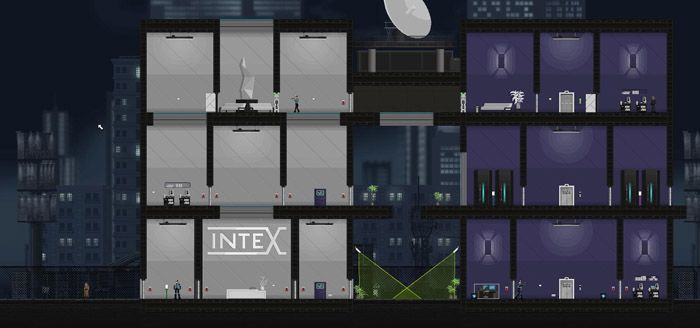
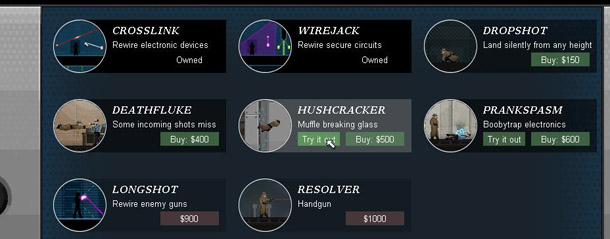
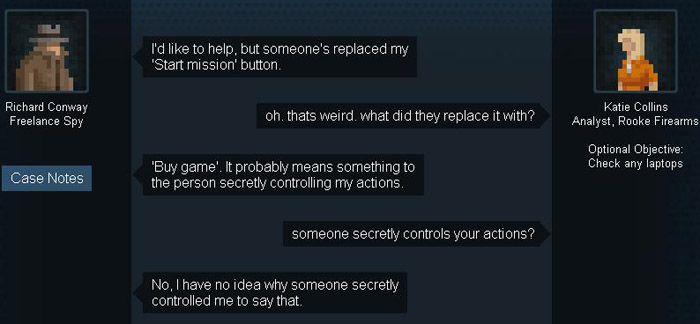
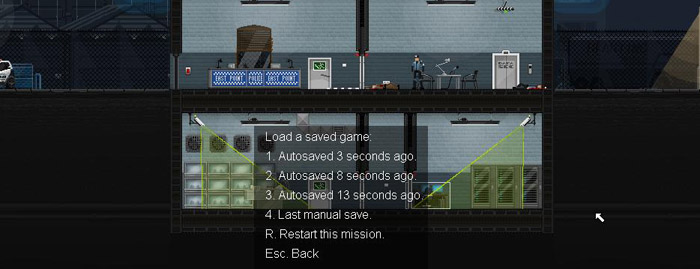
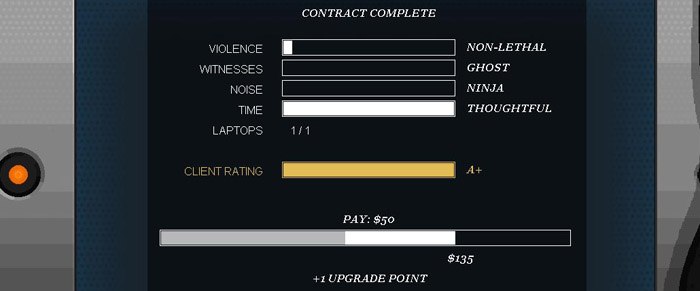

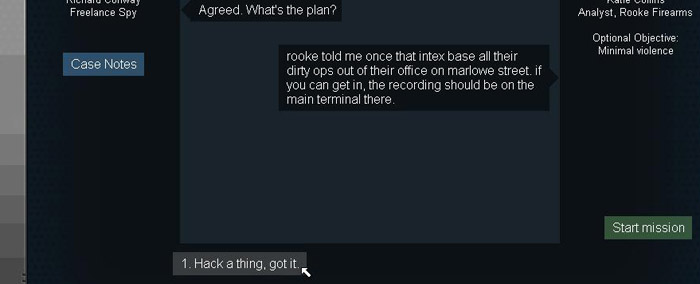

Wow, thanks man! Yep, all of these were intentional, I’m glad they went down well!
I did originally let you pounce us in the dev commentary, but it got annoying really fast: the commentary generally lasts longer than the level, so I find myself absent-mindedly jumping around, and if the commentary stops every time I accidentally jump into a developer I have to just sort of stop and twiddle my thumbs.
You can still shoot us with guns though.
Just bought it. Cheers to you both.
The part I’ve really liked (and I was up until midnight playing last night, cheers Tom), is that while a lot of games let you play in a style you like, eg stealth, killy etc. (such as in Deus Ex or Dishonoured), there’s generally only an incentive to play in one particular way. In Gunpoint, different mission givers want different things, one wants no living witnesses, so you have to work out how to kill every guard. another wants no violence, so you have to work out how to get round ever guard without punching them.
It’s a neat solution to the player just finding one style they like and sticking to it (although you tottaly can, you just won’t get max cash).
Another thing I noticed as I went to play through it again on my Steam copy: once you’ve completed the game, you can replay earlier missions with all the gadgets you’ve bought. Playing the early missions as essentially a superhero, you can really blast through them. Not exactly fair to the guards, but kicking all the doors down as a shortcut through the levels is fun!
Awesome game. Its just wayy too short. Should be like 300 levels with 5 bosses.